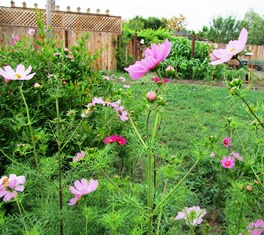Plants to Attract Hummingbirds
It’s hummingbird mating season. We’re seeing iridescent males with ruby throats engaged in amazing aerobatic flight patterns to attract females. To draw these birds to our garden, we’ve put in plants they are known to seek out.
To attract them, we’ve planted flowers with brightly colored blooms such as purple-spired agastache, red blooming wild columbine, cosmos (pink, white, and red) scarlet ipomopsis (also known as the hummingbird plant), larkspur (Giant Imperial has colors ranging from pink, dark blue, light blue, carmine, rose, salmon, and white), lobelia (various shades), poppies, and salvia (Fairy Queen has a brilliant purple color).
This morning as I was inspecting the peach tree, a male with a ruby throat perched on a branch right above the branch tip I was holding. I love seeing these little birds who are voracious feeders, consuming daily nearly half their body weight in nectar and feeding from the sugar-water feeders I’ve hung near my kitchen garden window six to eight times an hour.
Many of the above-mentioned plants also attract butterflies. Sow a few of each of these seeds and you’ll have visitors to your garden throughout the spring and summer months (or during each plant’s blooming season).
Letting Gardens Dry Up Is Hard On the Honeybees
My neighbor, a world-class beekeeper whose honey sells to many specialty markets and also Whole Foods, told me today honeybees in backyard hives in our East Bay communities are hungry. He has put out two five-gallon cans of sugar water to feed his bees.
Interestingly, I’ve noted bees at my hummingbird feeders also usurping the sugar water meant for the hummingbirds.
The honeybees do not make honey from sugar water. They just consume it to have energy to forage for pollen and to cool the hives on hot days. The drought means people are watering less; flower gardens and local landscape are dry, and in places the clay soil is cracking open. Bad news for bees.
Weatherwise, it’s been triple-digit hot and then cold and cloudy. I guess the bees will adapt but old timers say, “A swarm in July means bees go bye-bye.” This isn’t the right time for swarming.
My hived bees are loud and energetic. The bees faked me out with a small swarm about ten days ago and then returned to the hive; and now they are eating sugar water for energy to gather what pollen they can find to make honey. The honey will see the hungry hive through until the star thistle and the fall eucalyptus blooms. I’m torn between letting my bee-loving flowers dry up to conserve water, but I don’t want to lose my bees.
 Facebook
Facebook Goodreads
Goodreads LinkedIn
LinkedIn Meera Lester
Meera Lester Twitter
Twitter





